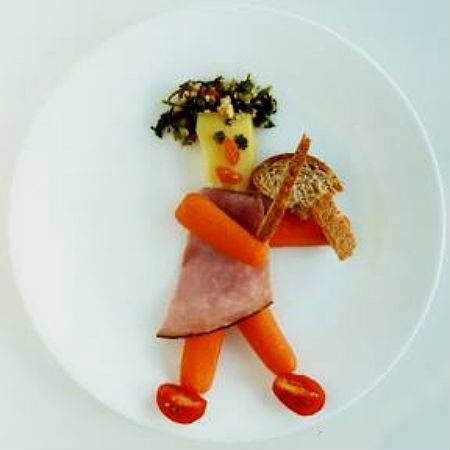BY: ALEX PIERCE-FELDMEYER
Do you ever feel that two superficially unrelated disciplines actually share commonalities once you dig a little deeper? Take science and art for example. They seem like totally different ends of a spectrum, but to a degree they often overlap making one not quite itself without the other. Consider artistic expression in the interior design world. Objectively speaking that is a creative and artistic enterprise, but in actuality there are doses of science spritzed into design elements, such as the renowned “rule of thirds.1” This rule describes how best to place design pieces in a room, which is based on the way the eye scans, focuses and what it tends to gravitate to. Pleasing designs that at first seem purely creative, actually have underlying scientific roots.
But I bet you’re wondering now, what the heck does this have to do with food? Isn’t this a food science blog I’m reading? Well, lately my experiences have lead me to feel that creating flavors and music have more in common than we might expect.
Now, you might have heard about the idea that sound plays a role in food sensations and perceptions. In fact, several studies have accounted for the role sound plays on our expectation of taste and flavor in food2. Spence (2016) goes as far as saying it is the sound of some foods, rather than their taste or appearance, that defines them. Would a potato chip be as satisfying if it didn’t crunch in your mouth? Or how about the sound the packaging makes of some of your favorite foods when you open them? What if your afternoon pick-me-up Coca-Cola did not have that iconic pah-shhh sound when you opened the can? Research has also found that manipulating background music during consumption of a product may affect your experience, particularly your liking of a food or beverage.3,4

While these phenomena are extremely interesting, they will have to wait for another time because this is not actually what I am talking about (sorry not sorry).
Don’t get me wrong—these are absolutely fascinating topics, but they aren’t the main idea of this blog. They, however, provide a great introduction for what I do want to bring to light in this post. Some of these studies show how music and flavor experiences can physiologically intermingle. Spence and Wang (2015) have argued there is a cross modal correspondence between sensory systems that are affecting the overall flavor experience, meaning sensory systems actually talk to each other in your brain, although we may experience stimuli independent of each other. Perhaps, different sensory systems may be more entwined than we think.
But, music and flavor, they sound pretty different, right?
That’s all good and dandy but what about music production? Instead of how music affects food flavor, let’s talk about how music and flavor are similarly produced.
Music and flavor development
A little bit of background: this blog article was born from the fact that my brother is a music producer, and I am a food scientist. He attended a school in California to train and gain credence as a producer of sound. From his school’s curriculum, they describe ‘ear training’ as a core skill that helps artists develop technical, critical and aesthetic skills for writing, recording and mixing music5. My brother and I talk a lot about our passions, mine being food science and his being music production. During our discussions, I could not help but notice how his descriptions of creating music echo the process a flavorist undergoes when creating their flavor.
And I quote from a previous SMF blog post from our one and only Bryan Le, “Flavorists use their olfactory and gustatory memory to synthesize a desired flavor for a product, much like how a pianist must bring together notes to play a song6 …”
Much like musicians who are tasked with both developing their aesthetic and innovating new music, flavorists are often tasked with the same job—create something new that we haven’t tasted, but using ingredients (similar to how sounds/instruments are used in music) that we are already familiar with. If you ever interview music producers, they talk a lot about how they combine sounds in a way to produce something more beautiful and harmonious than the individual parts of a musical piece. They reference tools (or ingredients): melody, rhythm, harmony and form and go on to say that every musician creates music differently (as a flavorist might create flavors differently than their co-worker).

Professional training
The professional training of both music producers and flavorists sound similar as well. My brother talks about ear training, and how his class had to listen to different components like white noise and sine waves, perhaps much like a flavorist has to learn all about various compounds that provide fruity or creamy notes. Throughout my investigation, it even got more congruous: another producer mentioned that the same sound wave at different levels can create very different sounds. This reminds me a lot of the way flavors work – volatile flavor compounds can smell and taste nasty at a high level but can be necessary components in your favorite flavors at minor concentrations, such as skatole which has a fecal odor at high concentrations but provides floral notes at lower concentrations.
Signature sounds and flavors
New music is built with traditional instruments, flavor is built with traditional ingredients but it is up to both artists to mix, layer, and synthesize a new product. Both artists are tasked with using traditional methods and learning the fundamentals before deviating and innovating from the norm.
One of my favorite quotes from Bryan’s blog article6 really underscores the relatability of flavor and music production.
“In some way, an experienced flavorist imparts some of their own signature into a flavor, adding nuances that tell a personal as well as a professional story6.
In seemingly totally unrelated fields musicians would, I think, find a kinship with flavorists. Just like the quote says a flavorist imparts a signature, adding nuances to tell a personal and professional story—you could substitute ‘flavorist’ with musician, and you’d have musicians impart a signature, adding nuances and they certainly tell a story with their craft as well. Just take a look at T-Swift…almost every song tells a story and she definitely has a musical signature, much like most bands or musicians. Sometimes you hear a song and you just know what musician it belongs to. The same could be said for professional flavorists.
It has even been said that some flavorists can tell who made a particular flavor by taste alone6.”
Just like trained musicians, upon becoming a professional flavorist you lean towards a way of doing things, personalizing the way you build a flavor. It certainly isn’t mind boggling to think you could recognize a Beatles song without being told the Beatles performed it. Just like a performer has a definitive voice or sound, a flavorist can have a definitive flavor signature.
Even the jargon used when describing these professions overlaps. After training, flavorists “develop their own ‘masterpiece’ flavor compositions7.”
Flavor compositions…musical compositions…both building works off of traditional components. Are we seeing the pattern?

Conclusion
One final note (be it musical or flavorful) that I will leave you with is another interesting relationship between music and flavor that I discovered. In both music and flavor, each individual ingredient for a song or flavor often go undetected –that is we do not recognize just the guitar notes in a favorite song, neither do we pick up on the linalool compound in a blueberry flavor. We experience both the music and flavors as one entity—one experience. Or how about how an ‘oldie but goodie’ song is reminiscent of the concept of classic flavors—PB & J, milk and cereal…etc. There are so many ways you can see how music and flavor are related. In fact it is likely you will come up with a few on your own not mentioned here.
*If you’re interested in another way music and flavor can combine for a more extreme experience take a gander at a previous blog written by me on synaesthesia8, a condition where people may actually experience flavors when certain sounds are heard. AND for a spin off of this analogy please check out this blog.
References
-
https://www.interaction-design.org/literature/article/the-rule-of-thirds-know-your-layout-sweet-spots
-
Spence, C. (2016). Sound: The Forgotten Flavor Sense. In Multisensory Flavor Perception: From Fundamental Neuroscience Through to the Marketplace (pp. 81–105). https://doi.org/10.1016/B978-0-08-100350-3.00005-5
-
Spence, C., & Wang, Q. (2015). Wine and music (II): can you taste the music? Modulating the experience of wine through music and sound. Flavour, 4(1), 33. https://doi.org/10.1186/s13411-015-0043-z
-
Kantono, K., Hamid, N., Shepherd, D., Yoo, M. J. Y., Grazioli, G., & Carr, B. T. (2016). Listening to music can influence hedonic and sensory perceptions of gelati. Appetite, 100, 244–255. https://doi.org/10.1016/j.appet.2016.02.143
-
https://iconcollective.com/curriculum/
-
https://sciencemeetsfood.org/of-flavors-and-flavorists/
-
https://www.symrise.com/careers/symrise-academy/flavor-academy/
-
https://sciencemeetsfood.org/?s=synaesthesia






Leave a Reply